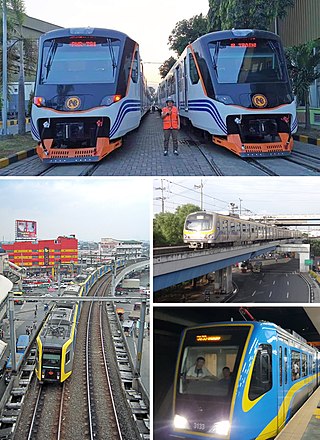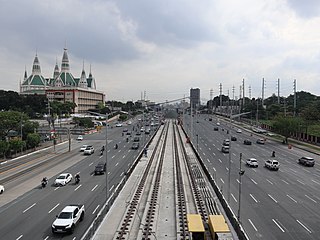
Metropolitan Manila, commonly shortened to Metro Manila and formally the National Capital Region, is the capital region and largest metropolitan area of the Philippines. Located on the eastern shore of Manila Bay, the region lies between the Central Luzon and Calabarzon regions. Encompassing an area of 636.00 km2 (245.56 sq mi) and with a population of 13,484,462 as of 2020, it is composed of sixteen highly urbanized cities: the capital city, Manila, Caloocan, Las Piñas, Makati, Malabon, Mandaluyong, Marikina, Muntinlupa, Navotas, Parañaque, Pasay, Pasig, Quezon City, San Juan, Taguig, and Valenzuela, along with one independent municipality, Pateros. As the second most populous and the most densely populated region in the Philippines, it ranks as the 9th most populous metropolitan area in Asia and the 6th most populous urban area in the world.

Quezon City, also known as the City of Quezon and Q.C., is the most populous city in the Philippines. According to the 2020 census, it has a population of 2,960,048 people. It was founded on October 12, 1939, and was named after Manuel L. Quezon, the second president of the Philippines.

Epifanio de los Santos Avenue, commonly referred to by its acronym EDSA, is a limited-access circumferential highway around Manila, the capital city of the Philippines. It passes through 6 of Metro Manila's 17 local government units or cities, namely, from north to south, Caloocan, Quezon City, San Juan, Mandaluyong, Makati, and Pasay.

The Quezon Memorial Circle, a national park situated in Quezon City, Philippines is a prominent landmark located within a large elliptical traffic circle bounded by the Elliptical Road. Serving as the main park of Quezon City, which was the official capital of the Philippines from 1948 to 1976, the park is renowned for its centerpiece: a 66-meter (217 ft) tall mausoleum. This monument enshrines the remains of Manuel L. Quezon, the second official President of the Philippines and the first president of an internationally recognized independent Philippines, alongside his wife, First Lady Aurora Quezon.

Rail transportation in the Philippines is currently used mostly to transport passengers within Metro Manila and provinces of Laguna and Quezon, as well as a commuter service in the Bicol Region. Freight transport services once operated in the country, but these services were halted. However, there are plans to restore old freight services and build new lines. From a peak of 1,100 kilometers (680 mi), the country currently has a railway footprint of 533.14 kilometers (331.28 mi), of which only 129.85 kilometers (80.69 mi) are operational as of 2024, including all the urban rail lines. World War II, natural calamities, underspending, and neglect have all contributed to the decline of the Philippine railway network. In the 2019 Global Competitiveness Report, the Philippines has the lowest efficiency score among other Asian countries in terms of efficiency of train services, receiving a score of 2.4, and ranking 86th out of 101 countries globally. The government is currently expanding the railway network up to 1,900 kilometers (1,200 mi) by 2022 through numerous projects.

Ayala Malls Trinoma is a large shopping mall in Quezon City, Philippines, owned by property development firm Ayala Land. Opened on May 16, 2007, the mall is located on the east side of Epifanio de los Santos Avenue in Quezon City, giving significant market competition to the nearby SM North EDSA as one of the largest malls in Metro Manila. It is also one of two malls that will be serving Ayala Land's Vertis North township, which is located beside the mall, along with a new lifestyle block mall Ayala Malls Vertis North, similar to Greenbelt in Makati, which was also developed by Ayala Malls.

Commonwealth Avenue, formerly known as Don Mariano Marcos Avenue, is a 12.4-kilometer (7.7 mi) highway located in Quezon City, Philippines. It spans from six to eighteen lanes, making it the widest road in the country. The avenue is one of the major roads in Metro Manila and is designated as part of Radial Road 7 (R-7) of the older Manila arterial road system and National Route 170 (N170) of the Philippine highway network.

Herbert Constantine "Bistek" Maclang Bautista is a Filipino actor and politician who served as mayor of Quezon City, the Philippines' largest city by population, from 2010 to 2019.
Quezon Memorial Circle station is an under-construction Metro Rail Transit (MRT) station located on the MRT Line 7 (MRT-7) and the proposed MRT Line 8 (MRT-8) systems within the Quezon Memorial Circle, Quezon City.

Manuel L. Quezon Avenue, more often called as Quezon Avenue, or simply Quezon Ave, is a 6.1-kilometer (3.8 mi) major thoroughfare in Metro Manila named after President Manuel Luis Quezon, the second president of the Philippines. The avenue starts at the Quezon Memorial Circle and runs through to the Welcome Rotonda near the boundary of Quezon City and Manila.

The Centennial Tower, also known as Luneta Tower, was a proposed mixed-use observation tower initially proposed to be located in Rizal Park, Manila, Philippines. It was later proposed to be built in Pasig amidst backlash over the original planned site. It was planned to be a memorial to the 100th anniversary of Philippine Independence.

Solaire Resort & Casino is a resort and casino in Entertainment City, a complex built along the Bay City area of Parañaque, in Metro Manila, Philippines.

Gambling in Metro Manila has been regulated since 1976 when the Philippine Amusement and Gaming Corporation (PAGCOR) was created through Presidential Decree 1067. Under its charter promulgated in 1983, the 100% state-owned PAGCOR, running under the direct supervision of the Office of the President, serves three crucial roles: to regulate and operate all games of chance in the country, particularly casino gaming; generate funds for the government's infrastructure and socio-civic projects; and boost local tourism.

The Vivaldi Residences Cubao is a 40-storey mixed use residential, condotel tower located at the corner of EDSA and Aurora Blvd. in Quezon City, Philippines. The tower was named after Antonio Vivaldi, and is both owned and developed by Euro Towers International Inc.. serving as the company's first high-rise residential project in Metro Manila.

The Metro Manila Subway, formerly known as the Mega Manila Subway (MMS) is an under-construction underground rapid transit line in Metro Manila, Philippines. The 33-kilometer (21 mi) line, which will run north–south between Valenzuela, Quezon City, Pasig, Taguig, Parañaque and Pasay, consists of 17 stations between the East Valenzuela and Bicutan stations. It will become the country's second direct airport rail link after the North–South Commuter Railway, with a branch line to Ninoy Aquino International Airport.

The Metro Rail Transit Line 7, also known as MRT Line 7 or MRT-7, is a rapid transit line under construction in the Philippines. When completed, the line will be 22.8 kilometers (14.2 mi) long, with 14 stations, and the first line to have a third rail electrification. The line runs in a northeast–southwest direction, beginning at San Jose del Monte, Bulacan up to the North Triangle Common Station in North Avenue, Quezon City.

NLEX Harbor Link, signed as E5 of the Philippine expressway network, is a four- to six-lane expressway that serves as a spur of North Luzon Expressway (NLEX) linking it to the Port of Manila to the west and Quezon City to the east. It runs from Katipunan and C.P. Garcia Avenues in Quezon City to Radial Road 10 in Navotas, which in turn leads to the Port of Manila. Currently, its segment from Mindanao Avenue in Valenzuela to Navotas is operational.

Bagong Pag-asa, also known as the Magsaysay District, is an administrative division in eastern Metro Manila. It is an urban barangay of Quezon City with low-density housing and is known for its shopping malls, transport hubs and office buildings.

Joy Belmonte is a Filipina politician who has served as the 11th mayor of Quezon City since 2019. A member of the local Serbisyo sa Bayan Party, Belmonte previously served as the vice mayor of Quezon City from 2010 to 2019 under her predecessor, Herbert Bautista.

Bridgetowne is a real estate development spanning the border of Pasig and Quezon City in Metro Manila, the Philippines. It is a mixed township and business park situated in a former industrial area on both banks of the Marikina River near the junction of Eulogio Rodriguez Jr. Avenue and Ortigas Avenue. The 30.61-hectare (75.6-acre) masterplanned community is the first integrated township project by Robinsons Land Corporation, the real estate arm of JG Summit. It is currently anchored by four office towers in its information technology park dedicated to the business process outsourcing sector, its second in Metro Manila after Robinsons Cybergate in Mandaluyong. Once completed, the township will be a community consisting of seven office towers, a shopping mall, five-star hotel and residential condominiums, with a landmark bridge and a light art installation called The Victor as its centerpiece.




















